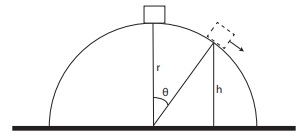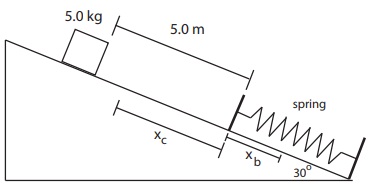Assignment:
Please write your solutions on this question paper! Solutions are not considered complete without the logical argument and/or full calculation.
1. Some road engineers in Montgomery, Alabama built a banked turn for a circular cloverleaf style highway entrance ramp. Unfortunately, they misread the blueprints and built the turn so that the slope banked outwards instead of inwards. If the road had been built properly, there road would have have made an angle of 25? with the horizontal, tilted towards the center of the turn.
Instead, the road tips away from the center of the circular turn at 25? to the horizontal. The radius of the turn is 50 m. In dry conditions, the coefficient of static friction between tires and the road can be treated as µs = 0.8. Carefully draw a force diagram for the car on the turn. Be sure to include the static friction force, normal force, and weight of the car. Label also the direction in which the net force must act if the car maintains a constant speed and radius of turn. What is the maximum speed in ms-1 that a car can drive around this turn without slipping outward toward the edge of the road?
2. A marble of mass 10 g falling through a tank of liquid experiences a resistive force R proportional to its velocity. Specifically, R = -bv, where b = 3.5 × 10-2 kg s-1 . The marble is dropped from rest and begins to accelerate downward. What is the marble's terminal velocity in this liquid? How much time elapses before the marble has reached 90% of its terminal velocity?
3. Two massive objects interact gravitationally. The force on object 1 (with mass m1) is given by FG = -Gm1m2/r2ˆr where r is the distance from object 2 to object 1,ˆr is simply a unit vector pointing from outward from object 2 towards object 1, and the minus sign indicates that the force experienced by object 1 points towards object 2 (an attractive force). Find an expression for the work done by a force that moves object 1 away from object 2 (at constant velocity) until it is a distance 2r away from object 2.
4. (Based on what was reported to me as a true story.) Your adrenaline-junkie friend loves bungee jumping. He wants to try something new, so is planning a static line (not elastic) swing jump. This will involve tying one end of the 50 m long rope to the center of a bridge 70 m over a river, walking down the bridge 50 m, so that the rope is fully extended, and then jumping off the bridge while harnessed to the other end of the rope so that you swing down in a circular arc. He decides that you, he, and three other friends can all do the jump at the same time harnessed together to the same rope.
In total, all five of you have a mass of 375 kg. He has bought a rope that can support 9, 000 N of tension without breaking. How do you think the jump goes and why? Will you be doing more jumps with him in the future? Support your answer with a calculation, considering the maximum force the rope must be able to support.
(You can ignore any effects of air resistance.)
5. A particle is placed so that it is momentarily at rest directly on top of a frictionless hemisphere, with radius r, that is sitting flat side down on the ground. The particle then begins sliding down off the hemisphere. At what height above the ground (in terms of r) does the particle lose contact with the hemisphere? (Hint: you may wish to consider what radial component of the particle's force must be for it to remain on the hemisphere.)

6. A spring that obeys Hooke's Law, with spring constant k = 400 N/m lays along an incline, at 30? to the horizontal. A block of mass 5.0 kg is released 5.0 meters up to slope from the end of the spring, so that it will slide down onto the spring. The coefficient of kinetic friction between the block and the surface is µk = 0.1 (assume that the static friction coefficient is low enough that the block begins to slide immediately when released).
(a) What is the kinetic energy of the block just before it collides with the spring?
(b) How far is the spring compressed by the block? (This distance is xb in the diagram.)
(c) After bouncing off the spring the block travels back up the slope. How far back up the slope does the block travel after bouncing off of the spring? (This distance is xc in the diagram.)
